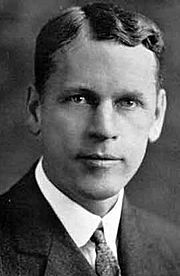Oswald Veblen facts for kids
Quick facts for kids
Oswald Veblen
|
|
|---|---|

Oswald Veblen (photograph c. 1915)
|
|
| Born | June 24, 1880 Decorah, Iowa, U.S.
|
| Died | August 10, 1960 (aged 80) Brooklin, Maine, U.S.
|
| Citizenship | United States |
| Alma mater | University of Iowa Harvard University University of Chicago |
| Scientific career | |
| Institutions | Princeton University Institute for Advanced Study |
| Thesis | A System of Axioms for Geometry (1903) |
| Doctoral advisor | E. H. Moore |
| Doctoral students | J. W. Alexander H. Roy Brahana Alonzo Church Philip Franklin Harold Hotelling Howard H. Mitchell Robert Lee Moore Tracy Thomas J. H. C. Whitehead |
Oswald Veblen (born June 24, 1880 – died August 10, 1960) was an American mathematician. He was an expert in geometry (the study of shapes and spaces) and topology (a branch of mathematics that looks at properties of spaces that stay the same even when stretched or bent).
His work was very important for understanding atomic physics and Albert Einstein's theory of relativity. In 1905, he proved the Jordan curve theorem, which is about how a simple closed loop divides a flat surface into an inside and an outside.
Contents
Early Life and Education
Oswald Veblen was born in Decorah, Iowa. His father, Andrew Anderson Veblen, was a physics professor. His mother was Kirsti Veblen. Oswald's uncle was Thorstein Veblen, a famous economist.
Oswald went to school in Iowa City, Iowa. He earned his first university degree from the University of Iowa in 1898. He then got another degree from Harvard University in 1900.
For his advanced studies, he went to the University of Chicago. There, he earned his Ph.D. (a high-level university degree) in mathematics in 1903. His main project was called A System of Axioms for Geometry. During World War I, Veblen served in the United States Army as a captain and later a major.
Career Highlights
Veblen taught mathematics at Princeton University from 1905 to 1932. He became a very respected professor there.
In 1932, he helped start the Institute for Advanced Study in Princeton. This is a famous place where smart people can do research without teaching classes. Veblen became one of the first professors at this institute. He stayed there until he retired in 1950.
Oswald and his wife, Elizabeth, owned land near Princeton. In 1957, they gave over 80 acres of their land to create the Herrontown Woods Arboretum. This is a large nature preserve in Princeton, New Jersey, where people can enjoy nature.
Veblen was invited to speak at important math conferences around the world. He spoke at the International Congress of Mathematicians in 1928 and 1936.
He passed away in Brooklin, Maine, in 1960 when he was 80 years old. After his death, the American Mathematical Society created a special award in his honor. It's called the Oswald Veblen Prize in Geometry. This award is given every three years to mathematicians who do amazing research in geometry.
Key Accomplishments
Oswald Veblen made big contributions to topology and different types of geometry. His ideas were very important for modern physics.
- He created the Veblen axioms, which are basic rules for projective geometry.
- He also helped develop the Veblen functions, which are used in advanced mathematics.
- During World War II, he helped with ballistics work. This involved studying how projectiles (like bullets or rockets) fly. He supported the creation of early computing machines, including the famous ENIAC electronic digital computer.
- In 1912, he also published a paper about the four-color conjecture. This is a famous problem in mathematics about coloring maps so that no two neighboring regions have the same color.
Personal Life
In 1908, Oswald Veblen married Elizabeth Richardson. Her brother was Owen Willans Richardson, a British physicist. Her sister was married to Clinton Davisson, another American physicist.
Images for kids
See also
 In Spanish: Oswald Veblen para niños
In Spanish: Oswald Veblen para niños


